Unleashing the Potential of Follow-up Letters: 32 Expertly Crafted Templates for Contract Negotiations
Welcome to our website dedicated to follow-up letters for contract negotiations! We understand the importance of effective communication in navigating the complexities of contractual agreements. Follow-up letters serve as valuable tools to maintain clarity, address concerns, and foster productive dialogue throughout the negotiation process. Whether you are a seasoned negotiator or new to the world of contract negotiations, our website is designed to provide you with valuable resources, guidance, and practical tips on writing impactful follow-up letters. Explore our content to enhance your negotiation skills, refine your communication strategies, and achieve successful outcomes in your contract negotiations. We are here to support you in your journey towards effective contract negotiation and building strong, mutually beneficial business relationships.
Benefits of Using Contract Negotiations Follow-up Letters
Using follow-up letters for contract negotiations offers several benefits, including:
- Clarification and Documentation: Follow-up letters provide an opportunity to clarify any ambiguities or misunderstandings that may arise during contract negotiations. They serve as a written record of discussions, agreements, and important points, ensuring that all parties have a clear understanding of the terms and conditions.
- Reinforcement of Position: Follow-up letters allow you to reinforce your position and ensure that your interests are accurately represented. By summarizing the key points discussed, restating your position, and highlighting the agreed-upon terms, you can solidify your stance and ensure that it is properly communicated to the other party.
- Professionalism and Organization: Sending follow-up letters demonstrates professionalism and organization in your approach to contract negotiations. It shows that you take the process seriously and value clear and concise communication, which can help build trust and credibility with the other party.
- Conflict Resolution: Follow-up letters can be used as a tool to address any conflicts or disagreements that may arise during negotiations. By calmly and professionally addressing concerns, proposing solutions, and seeking clarification, you can work towards resolving conflicts and finding common ground.
- Documentation for Future Reference: Follow-up letters serve as a valuable source of documentation for future reference. If any disputes or disagreements arise later on, having a written record of the negotiation process can be instrumental in resolving conflicts and protecting your interests.
- Time Management: Follow-up letters help in managing time effectively during contract negotiations. They provide a concise summary of the key points discussed, allowing all parties to refer back to the letter instead of rehashing the entire discussion, which can save time and streamline the negotiation process.
- Negotiation Strategy and Leverage: Well-crafted follow-up letters can also serve as a negotiation strategy and leverage tool. By clearly articulating your position, outlining potential consequences, or proposing alternatives, you can influence the negotiation process and potentially achieve more favorable terms.
- Professional Relationship Building: Effective communication through follow-up letters can contribute to building and maintaining a positive professional relationship with the other party. Clear and respectful communication can foster trust, open channels for future collaborations, and lay the foundation for a successful long-term business relationship.
Continuous Improvement
Embracing a mindset of continuous improvement in contract negotiations is vital for enhancing our negotiation strategies over time. It is crucial to regularly review and evaluate the effectiveness of our follow-up letters to identify areas for refinement and enhancement. One suggestion is to assess the clarity and conciseness of our communication. Are the key points clearly conveyed? Can we simplify complex language or structure our letters more effectively? Additionally, seeking feedback from counterparts or colleagues involved in the negotiation process can provide valuable insights and perspectives. Did the follow-up letters effectively address concerns and facilitate productive discussions? Analyzing the outcomes of negotiations and considering the impact of our letters can help identify strengths and areas for growth. By embracing a learning mindset and continuously refining our follow-up letter approaches, we can elevate our negotiation skills and achieve even more successful outcomes in future negotiations.
#1: Appreciation letter for successful contract negotiation
An appreciation letter for successful contract negotiation is a powerful tool to express gratitude and acknowledge the efforts and achievements of all parties involved in reaching a mutually beneficial agreement. This letter serves to recognize the collaborative spirit, professionalism, and dedication exhibited throughout the negotiation process, fostering goodwill, and strengthening the business relationship. It allows for a moment of reflection on the successful outcome and expresses sincere appreciation for the time, expertise, and commitment invested by all parties to secure a favorable contract.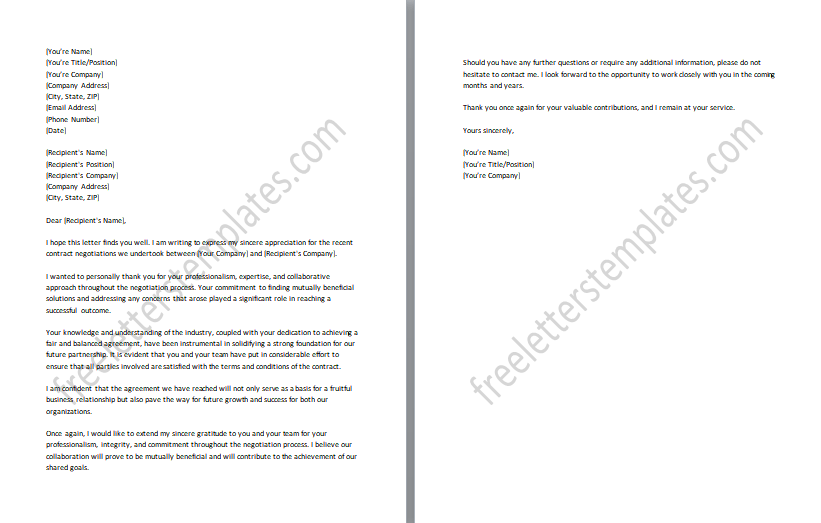
#2: Confirmation letter of contract terms
A confirmation letter of contract terms is a formal communication that serves to validate and document the agreed-upon terms and conditions of a contract. This letter reiterates the key provisions, obligations, and rights established during the negotiation process, ensuring a clear understanding between the parties involved. It serves as a reference document for future interactions, minimizing misunderstandings and disputes. The confirmation letter provides assurance and confidence to both parties that the contract has been accurately captured and establishes a foundation for the successful execution of the agreed-upon terms.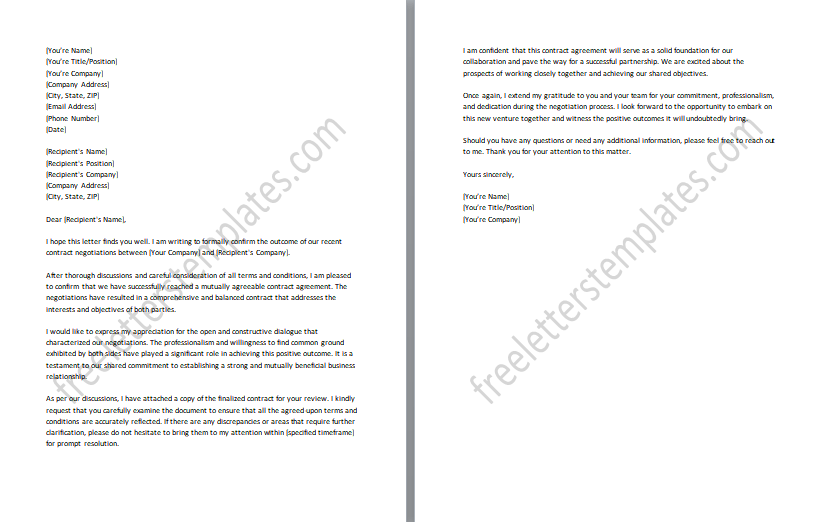
#3: Clarification request regarding contract negotiations
A clarification request regarding contract negotiations is a formal letter that seeks to obtain additional information or clarification on specific aspects of a contract that require further understanding. This letter highlights the need for clarity to ensure a comprehensive and accurate interpretation of the contractual terms. It expresses a commitment to resolving any ambiguities or uncertainties and promotes effective communication and collaboration between the parties involved. The clarification request aims to facilitate mutual understanding and alignment, reducing the risk of misinterpretation and potential disputes, and ensuring a smooth and successful implementation of the contract.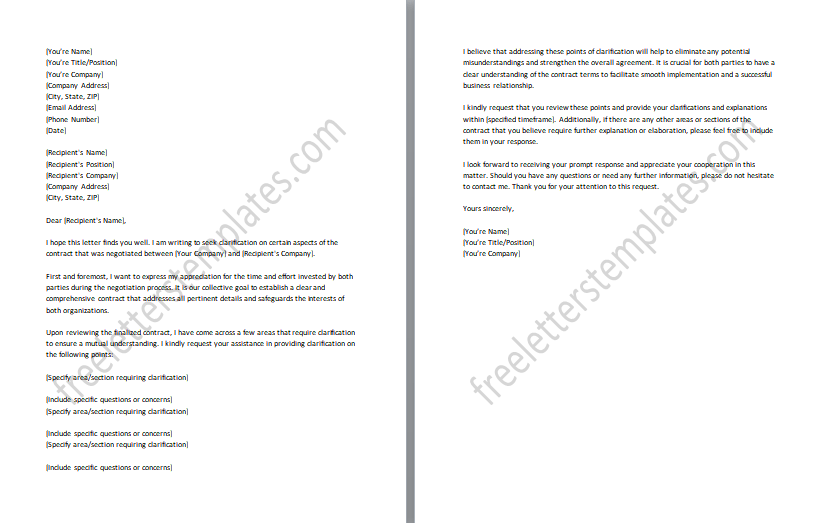
#4: Counteroffer proposal for contract terms
A counteroffer proposal for contract terms is a written communication that presents an alternative set of terms and conditions in response to a previously received contract offer. This letter outlines specific modifications or adjustments to the original offer, such as pricing, deliverables, timelines, or other contractual provisions. The counteroffer proposal aims to initiate a negotiation process, where both parties can find a middle ground that better aligns with their respective interests. It serves as a professional and formal means to express concerns, suggest improvements, and work towards a mutually acceptable agreement. The counteroffer proposal sets the stage for continued negotiations, promoting open dialogue and the potential for reaching a satisfactory resolution that benefits all parties involved.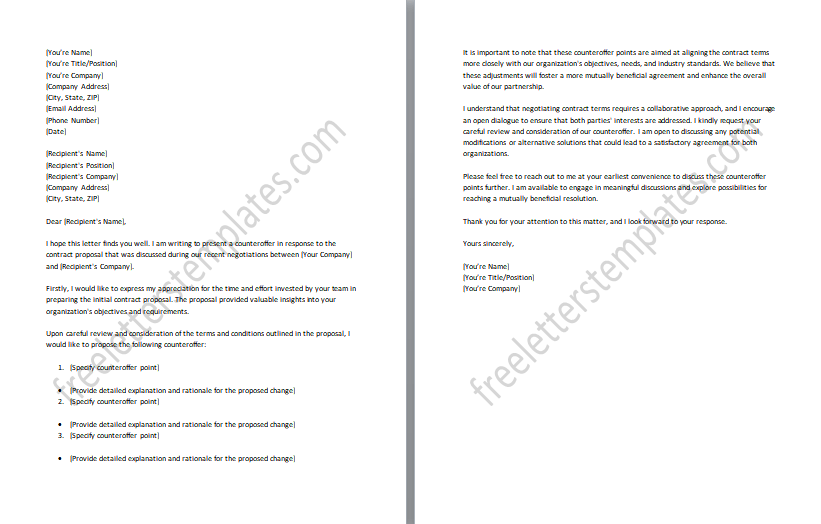
#5: Request for a contract extension
The purpose of this letter is to formally request a contract extension for a specific project or service. The letter is used to communicate the need for an extension due to evolving needs or unforeseen circumstances that have arisen during the collaboration. The primary purpose is to ensure the successful completion of the project or the continuation of a high level of service that has been consistently delivered. By requesting an extension, the letter aims to initiate a discussion and negotiation process with the recipient regarding the possibility of extending the contract to meet the ongoing requirements of the project or service.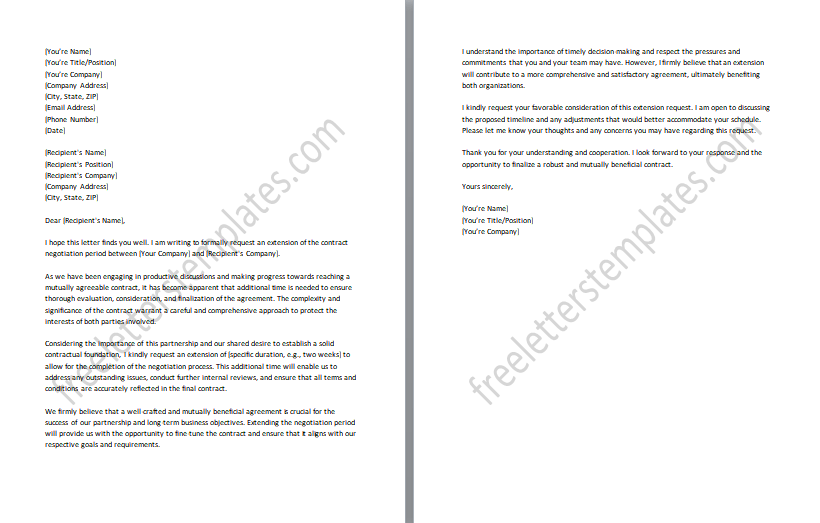
#6: Rejection letter for contract proposal
The purpose of this letter is to formally inform the recipient that their contract proposal for a specific project or service has been rejected. The letter is used to clearly and respectfully communicate the decision and provide an explanation as to why the proposal did not meet the requirements or align with the organization’s current business objectives. The letter aims to provide closure to the recipient, ensuring they are aware of the decision and understand the reasons behind it. Additionally, it allows the organization to maintain transparency and professionalism in its communication with the recipient, even in the context of rejection.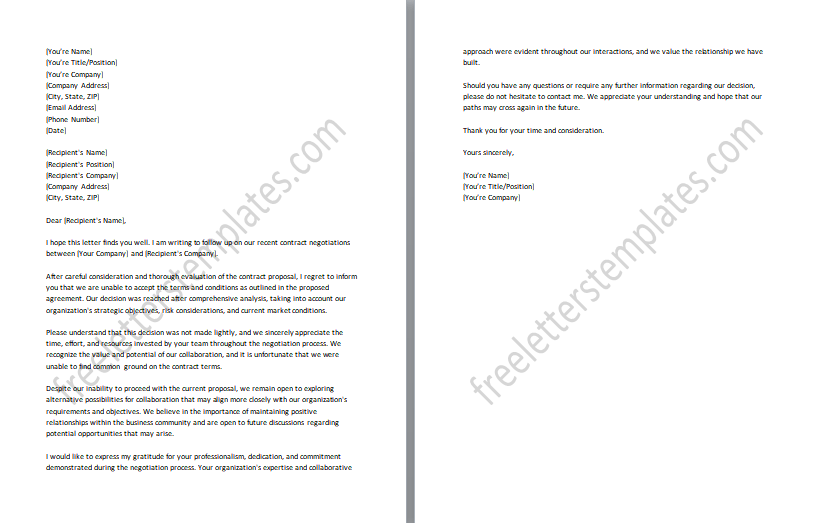
#7: Revised terms and conditions agreement
The purpose of this letter is to inform the recipient about a revised Terms and Conditions Agreement for an ongoing business relationship. It is used to communicate that the previous agreement requires modifications to better accommodate the evolving nature of the partnership and ensure fairness and clarity for both parties involved. The letter aims to initiate a discussion and negotiation process, providing the recipient with the updated terms and conditions that will govern future interactions and engagements.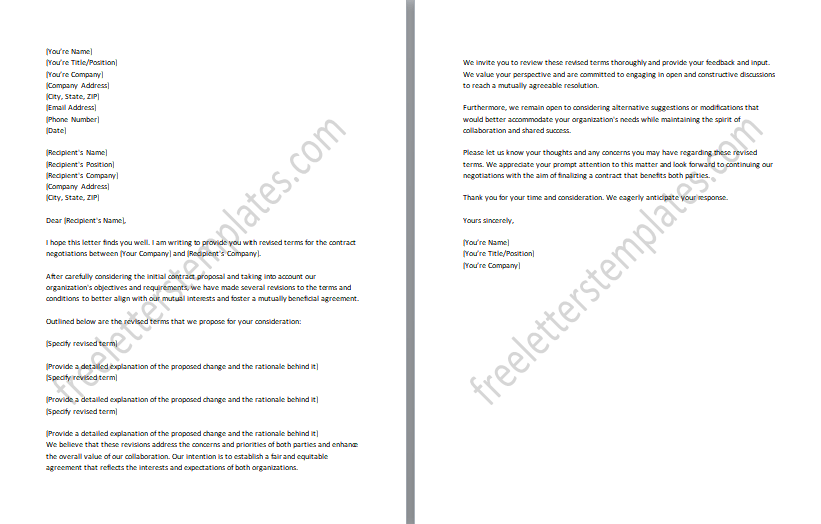
#8: Agreement acceptance letter for contract negotiations
I wanted to reach out and share some great news with you! This letter serves as my official confirmation of our mutual understanding and agreement on the terms and conditions we discussed and negotiated together. It’s a significant milestone that brings us onto the same page, ensuring that we both have a clear understanding of our rights, responsibilities, and expectations. By putting our acceptance in writing, we solidify our commitment and create a tangible record of our agreed-upon terms. I am genuinely excited about this partnership and look forward to a fruitful collaboration and the successful implementation of our project.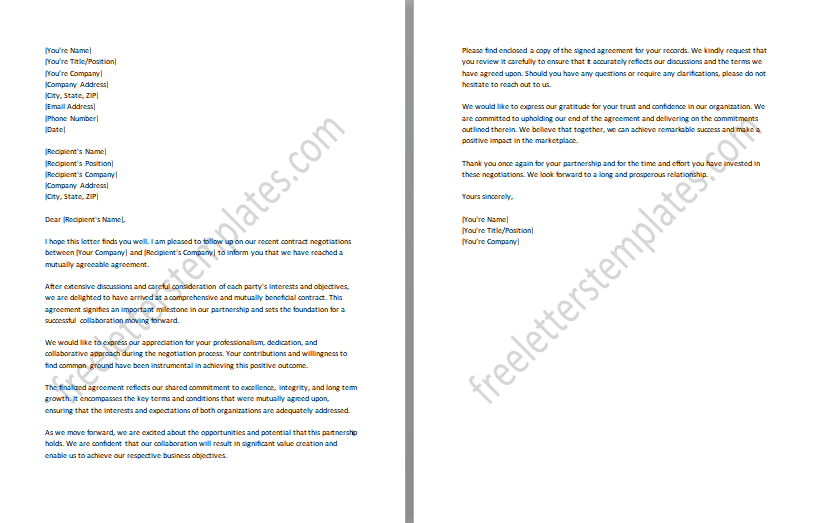
#9: Meeting request for further contract discussions
The purpose of this letter is to formally request a meeting to engage in further discussions regarding a contract. The letter is used to communicate the need for additional conversations and negotiations to address specific aspects or clarify certain terms of the contract. Its primary usage is to initiate a productive dialogue between the parties involved, allowing them to align their interests, resolve any outstanding issues, and potentially reach a more satisfactory agreement.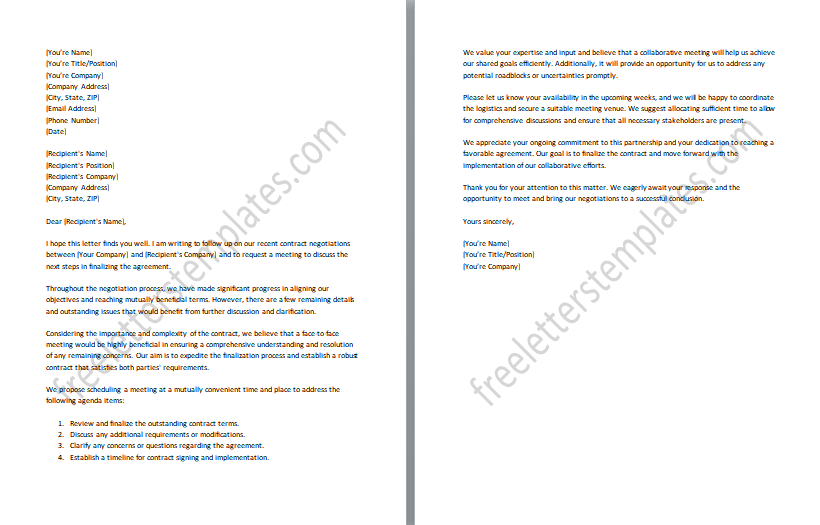
#10: Legal review feedback on contract negotiations
The purpose of this letter is to provide legal review feedback on contract negotiations that have taken place. The letter is used to communicate the legal team’s assessment and recommendations regarding the proposed contract terms and conditions. It aims to highlight any legal concerns, potential risks, or areas that require clarification or modification to protect the interests of the organization. The letter serves as a valuable tool to provide guidance and insights to the negotiating parties, enabling them to make informed decisions and work towards a more robust and legally sound contract. Its primary usage is to facilitate effective collaboration between the legal team and other stakeholders involved in the negotiation process, ensuring the final contract reflects the necessary legal considerations and safeguards.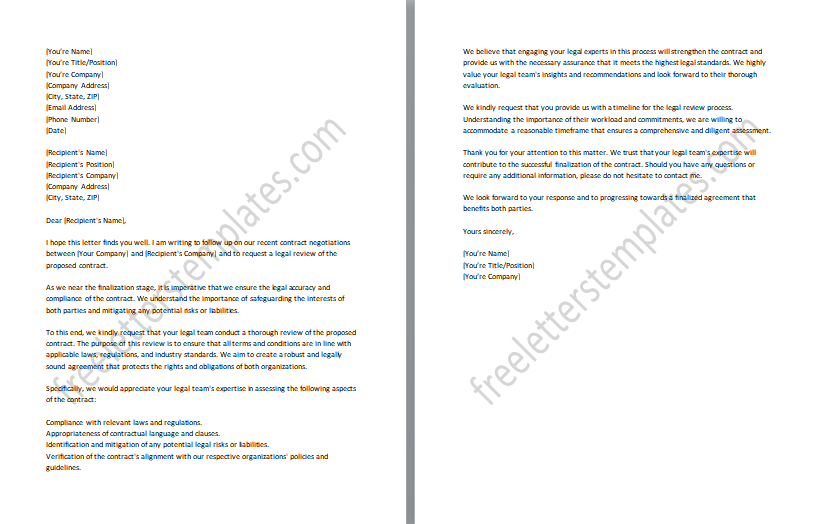
#11: Price adjustment request for contract terms
The purpose of this letter is to formally request a price adjustment for contract terms that have been agreed upon. The letter is used to communicate the need for a revision in the pricing structure or rates outlined in the contract. It aims to justify the requested adjustment, such as changes in market conditions, increased costs, or other relevant factors impacting the financial feasibility of the agreement. The letter seeks to initiate a discussion and negotiation process with the recipient to reach a mutually beneficial resolution that addresses the financial concerns while maintaining the integrity of the contract. Its primary usage is to assert the need for a fair and equitable price adjustment and to foster open communication to find a suitable compromise that meets the needs of both parties.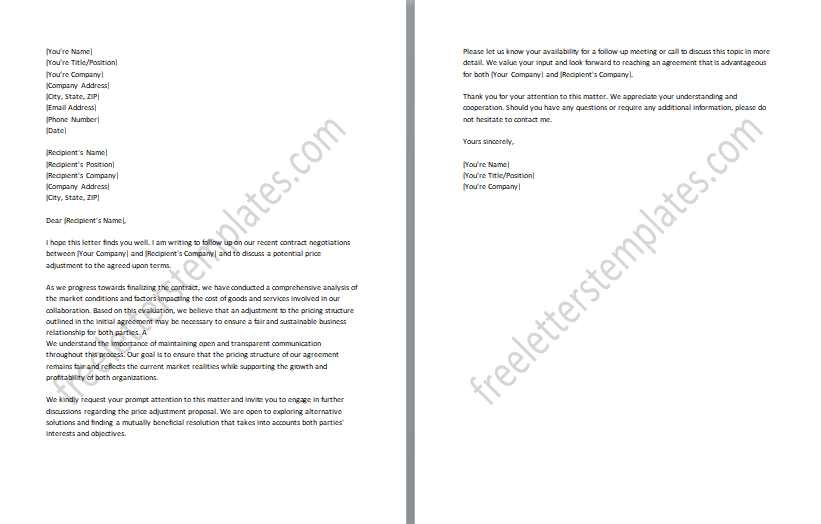
#12: Terms and conditions clarification letter
This letter serves as an opportunity to seek further understanding and clear up any uncertainties that may exist. I believe that open communication is vital to ensure we are on the same page and avoid any potential misunderstandings down the line. By seeking your insights and interpretation, we can work together to establish a shared understanding of the specific details and intentions behind the contract terms. My goal is to foster a transparent and collaborative environment where both parties feel confident and aligned with the agreement. I look forward to your input and working toward a resolution that benefits us both.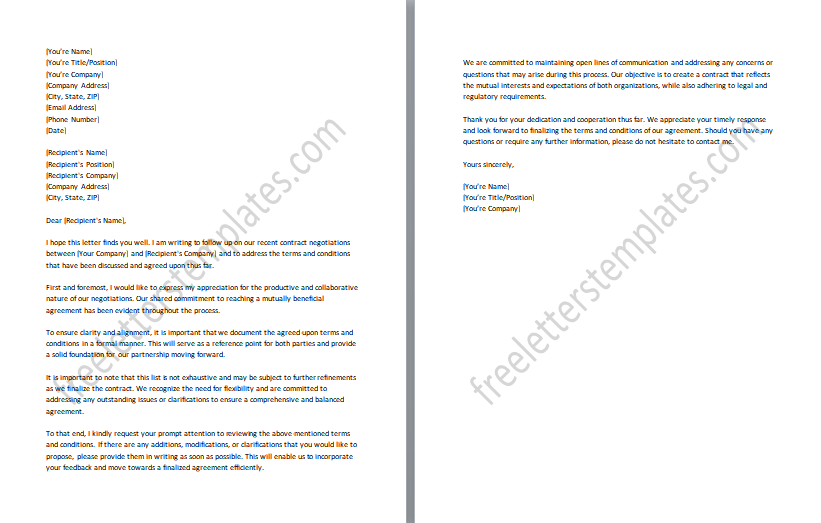
#13: Timeline adjustment proposal for contract negotiations
The purpose of this letter is to propose an adjustment to the timeline for ongoing contract negotiations. The letter is used to communicate the need for a revised schedule to accommodate unforeseen circumstances, changing priorities, or other factors that may affect the original timeline. Its purpose is to initiate a discussion and negotiation process with the recipient to explore the feasibility of adjusting the agreed-upon timeframe. The letter aims to present a well-justified proposal, outlining the reasons for the requested timeline adjustment and emphasizing the benefits and potential impact of the revised schedule on the successful completion of the contract. Its primary usage is to foster open communication, flexibility, and collaboration to ensure that the timeline aligns with the evolving needs and realities of the project or partnership.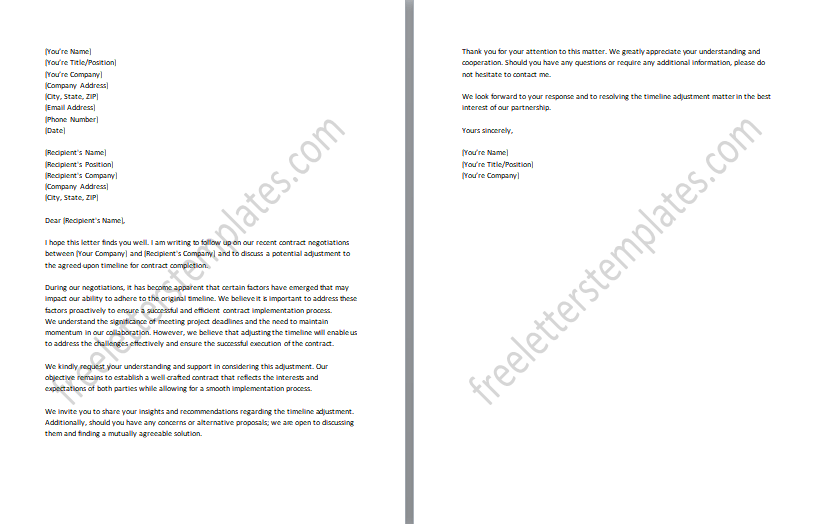
#14: Scope of work clarification letter
The purpose of this letter is to seek clarification on the scope of work outlined in a contract. The letter is used to address any uncertainties, ambiguities, or gaps in the defined scope, ensuring a clear understanding of the specific deliverables, tasks, and responsibilities involved in the project or service. Its purpose is to initiate a productive dialogue with the recipient to resolve any misunderstandings or discrepancies, thereby aligning expectations and avoiding potential conflicts. The letter aims to foster effective communication, collaboration, and mutual agreement on the precise scope of work, ultimately enhancing the successful execution of the contract and the satisfaction of all parties involved.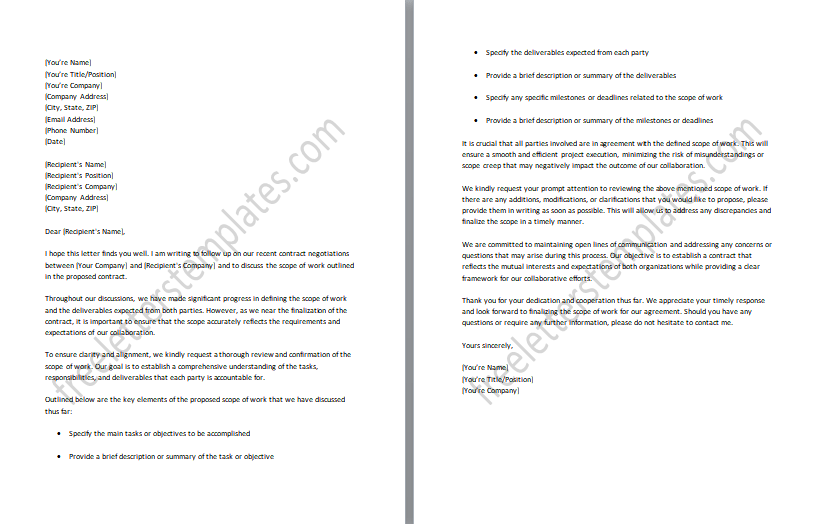
#15: Performance evaluation feedback on contract negotiations
The purpose of this letter is to provide performance evaluation feedback on contract negotiations that have taken place. The letter is used to assess and communicate the effectiveness, efficiency, and overall quality of the negotiation process. It aims to highlight strengths, areas of improvement, and any concerns or issues that may have arisen during the negotiations. The feedback provided in the letter is intended to be constructive, offering insights and recommendations to enhance future contract negotiation outcomes. The letter serves as a valuable tool to promote continuous improvement, collaboration, and professionalism in future negotiation endeavors. Its primary usage is to provide a comprehensive evaluation of the negotiation performance, facilitating learning and growth for both parties involved.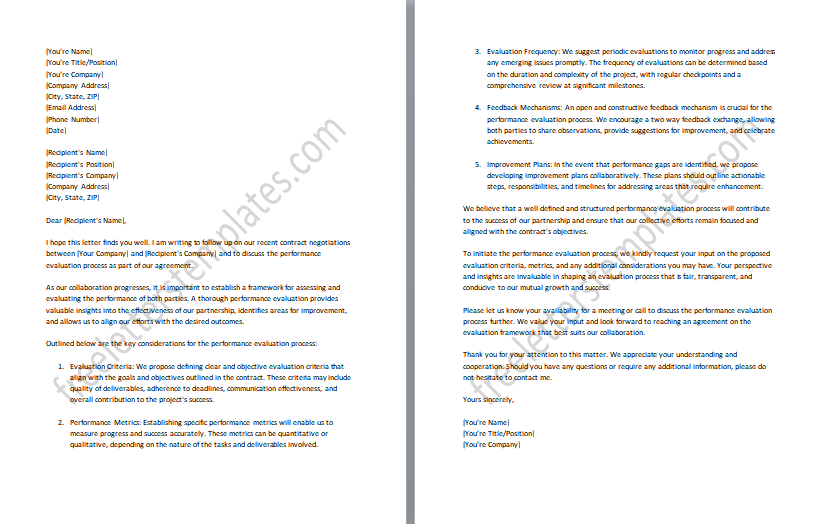
#16: Payment terms negotiation letter
A payment terms negotiation letter is a written correspondence used to initiate discussions and propose changes to the existing payment terms between two parties, such as a buyer and a seller or a service provider and a client. The purpose of this letter is to open a dialogue and negotiate more favorable payment terms that better align with the needs and preferences of both parties. It serves as a formal and professional means to address any concerns, suggest amendments, or request modifications to payment schedules, methods, due dates, discounts, or any other relevant terms. The letter aims to foster a constructive negotiation process and reach a mutually beneficial agreement that ensures both parties are satisfied with the financial aspects of their business relationship.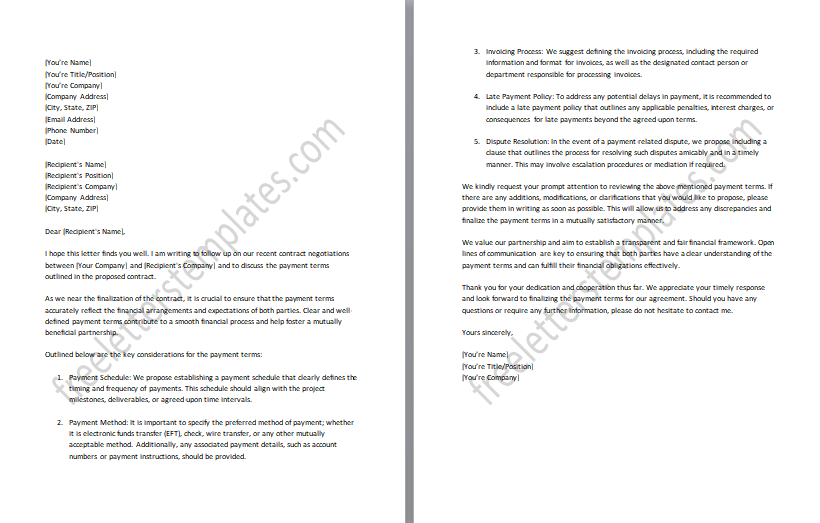
#17: Confidentiality agreement request for contract negotiations
A confidentiality agreement request letter for contract negotiations is a formal written communication used to request the signing of a confidentiality agreement before entering into detailed discussions and negotiations regarding a potential contract or business arrangement. The purpose of this letter is to establish a legal framework that ensures the protection and non-disclosure of sensitive information shared during the negotiation process. The letter serves as a means to emphasize the importance of confidentiality and to request the other party’s commitment to maintaining the confidentiality of the information exchanged. By requesting a confidentiality agreement, the letter aims to safeguard proprietary information, trade secrets, financial data, and any other confidential or sensitive materials that may be disclosed during the negotiation stage. Its ultimate goal is to create a secure environment that fosters open and transparent negotiations while preserving the privacy and competitive advantage of both parties involved.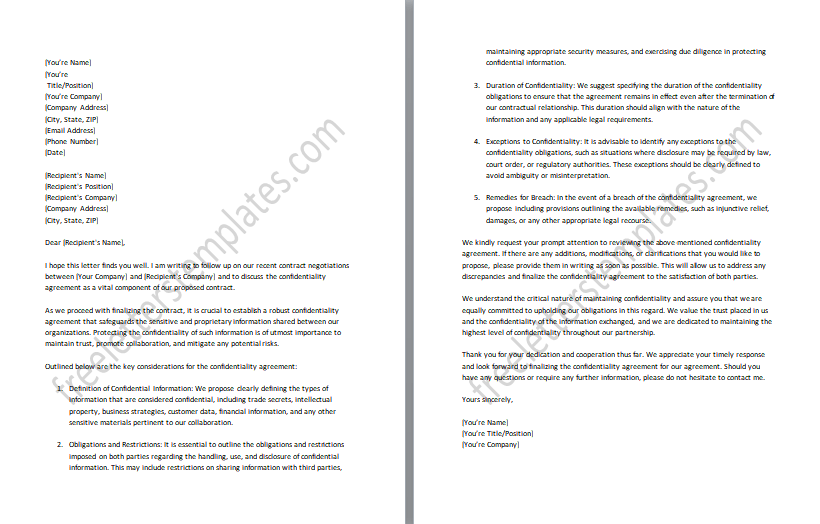
#18: Non-disclosure agreement modification letter
A non-disclosure agreement modification letter is a written communication that allows us to propose some changes or updates to our existing non-disclosure agreement (NDA). By sending this letter, we’re initiating a formal discussion to negotiate changes in provisions such as what exactly constitutes confidential information, how long the agreement should last, the responsibilities and obligations of each party, and other important clauses. Our goal is to ensure that the NDA remains effective, relevant, and mutually beneficial in safeguarding sensitive information while reflecting the updated requirements and expectations of everyone involved.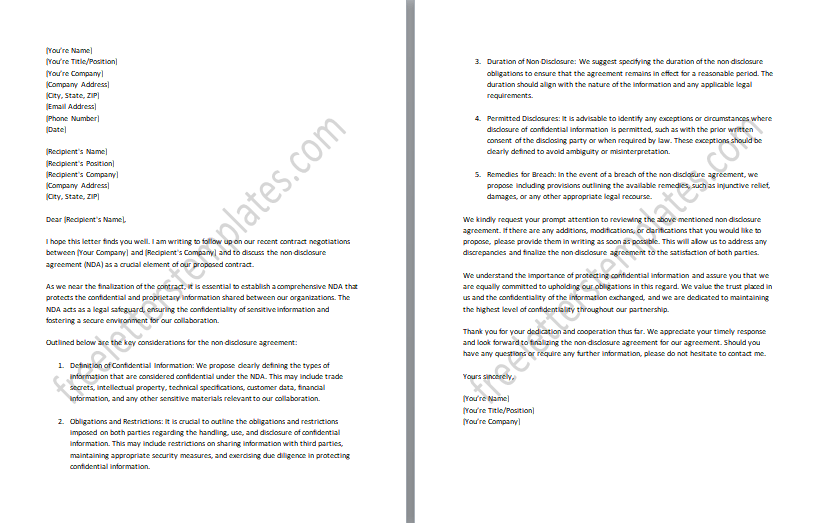
#19: Non-compete agreement terms discussion
When it comes to discussing the terms of a non-compete agreement, we aim to have an open and constructive conversation. We want to carefully explore and negotiate the specific details that will be included in the agreement. The main purpose of this discussion is to establish clear boundaries and restrictions regarding one party’s ability to compete with the other party’s business. We’ll delve into important aspects such as the scope of the non-compete clause, the duration of the agreement, the geographical limitations involved, and any potential exceptions or special considerations. Our goal is to strike a balance that protects the interests of the party seeking the non-compete, while also allowing the other party reasonable freedom to pursue their professional aspirations.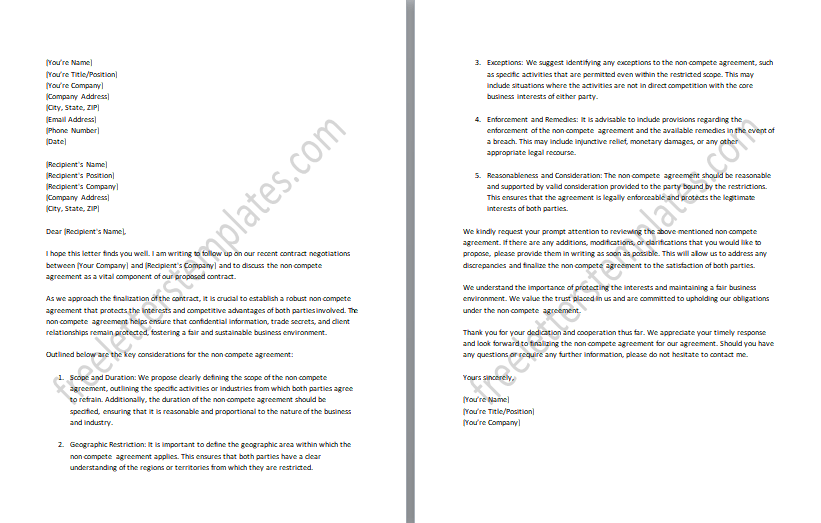
#20: Termination clause modification proposal
We are proposing a modification to the termination clause in our contract to address specific provisions. This proposal aims to align the termination clause with our changing needs and objectives. We seek to negotiate changes to elements such as notice periods, termination rights, remedies, and other relevant terms. By presenting this proposal, we aim to establish a balanced and mutually beneficial termination clause that reflects the updated requirements of both parties. Through open and constructive dialogue, we can reach a mutually agreed-upon modification that safeguards everyone’s interests and ensures a fair and smooth termination process when necessary.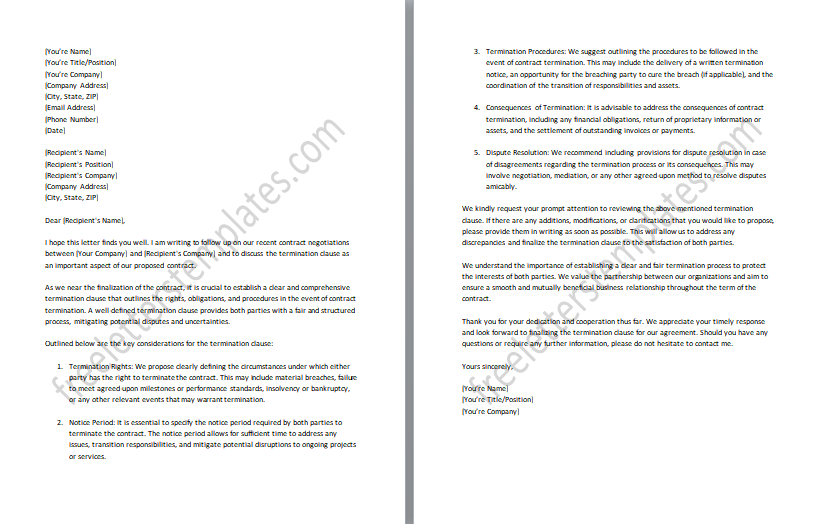
#21: Force majeure clause inclusion request
We are requesting the inclusion of a force majeure clause in our contract. The purpose of this request is to address unforeseen events or circumstances that may prevent or delay the performance of contractual obligations. By including a force majeure clause, we aim to allocate the risks associated with such events between the parties involved. This clause will outline the specific circumstances that would qualify as force majeure, the rights and obligations of each party during such events, and any necessary remedies or alternatives. Our goal is to establish a fair and comprehensive contractual framework that considers the potential impact of uncontrollable events, ensuring both parties are protected and allowing for appropriate adjustments in case of unforeseen circumstances.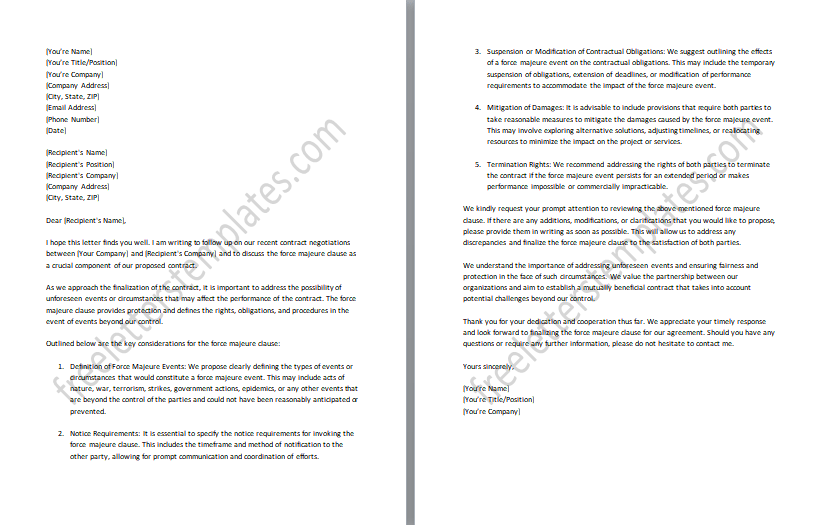
#22: Indemnity clause review and discussion
In our letter, we are initiating a review and discussion regarding the indemnity clause in our contract. The purpose of this communication is to carefully examine the existing indemnity clause and engage in a constructive dialogue to address any concerns or potential modifications. We aim to ensure that the indemnity clause provides adequate protection and allocation of liabilities for both parties involved. This discussion will cover aspects such as the scope of indemnification, the limitations and exceptions, the notification and cooperation requirements, and any other relevant provisions. By engaging in this review and discussion, our goal is to reach a mutually agreed-upon indemnity clause that effectively mitigates risks, protects the interests of all parties, and maintains a fair and balanced contractual relationship.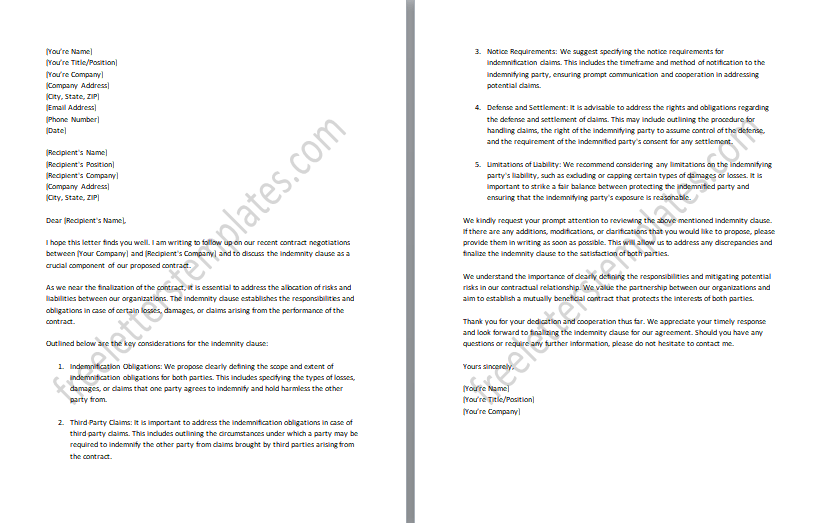
#23: Intellectual property rights clarification letter
A letter seeking clarification on intellectual property (IP) rights is a written correspondence used to request clear and comprehensive information regarding ownership, usage, and protection of intellectual property assets in a specific context, such as a business agreement or collaboration. The purpose of this letter is to address any uncertainties or ambiguities related to IP rights and seek clarification to ensure a mutual understanding between the involved parties. The letter seeks to clarify aspects such as ownership of IP, the extent of rights granted, permitted uses, restrictions, licensing terms, infringement remedies, and any other relevant details. By initiating this letter, the sender aims to foster transparency, prevent disputes, and establish a solid foundation for the appropriate management and protection of intellectual property assets by the parties’ intentions and legal requirements.
#24: Warranty terms negotiation proposal
A warranty terms negotiation proposal is a written communication used to initiate discussions and propose changes to the warranty terms outlined in a contract or agreement. The proposal aims to open a dialogue, suggesting amendments to aspects such as the duration of the warranty, coverage limitations, remedies, exclusions, or any other relevant terms. By presenting this proposal, the sender seeks to negotiate more favorable warranty terms that provide adequate protection and ensure customer satisfaction while balancing the business interests of the provider. The goal is to reach a mutually beneficial agreement that establishes clear and fair warranty terms, fostering a positive and trustworthy business relationship.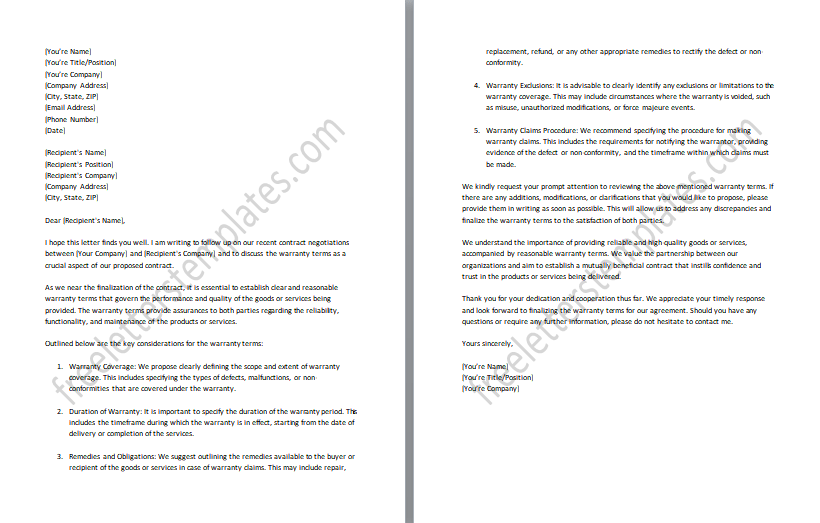
#25: Binding agreement finalization letter
A binding agreement finalization letter is a written communication used to confirm the agreement reached between parties and express the intent to finalize the terms of the contract or agreement. The purpose of this letter is to solidify the understanding and ensure that all parties are in agreement with the finalized terms and conditions. The letter typically outlines the key provisions of the agreement, including but not limited to the scope of work, payment terms, duration, responsibilities, and any other relevant details. It serves as a formal acknowledgment of the mutual consent and intention to move forward with the finalized agreement. By sending this letter, the parties confirm their commitment to abide by the terms of the agreement and proceed with the necessary steps to execute the contract.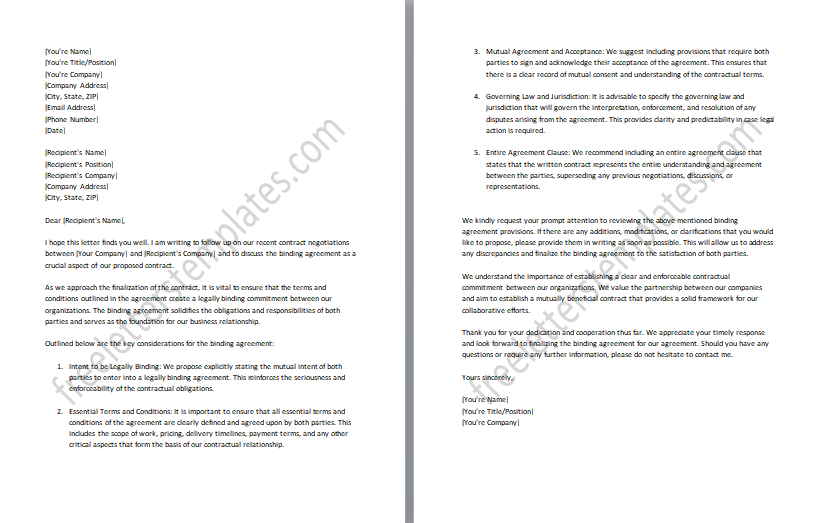
#26: Dispute resolution process discussion letter
A dispute resolution process discussion letter is a written communication used to initiate a conversation regarding the procedures and methods to resolve disputes that may arise between parties. The purpose of this letter is to establish a clear understanding and agreement on the steps and mechanisms that will be employed to address potential conflicts. The letter aims to open a constructive dialogue to discuss options such as negotiation, mediation, arbitration, or litigation, and determine the most suitable approach for resolving disputes. It may also cover topics such as the selection of a neutral third party, the timeline for resolution, confidentiality requirements, and any other relevant considerations.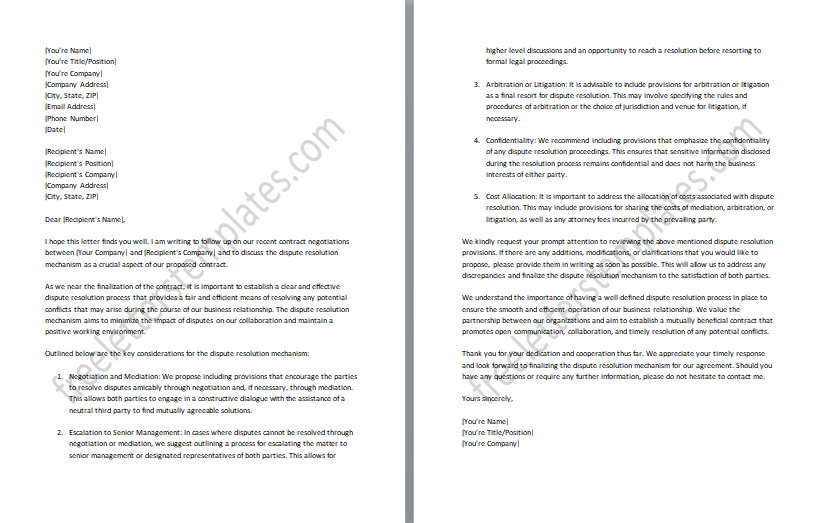
#27: Compliance requirements clarification letter
A compliance requirements clarification letter is a written communication used to seek clarification and obtain detailed information regarding specific compliance obligations and regulations that need to be met. The purpose of this letter is to address any uncertainties or ambiguities surrounding compliance requirements and ensure a clear understanding of the obligations placed upon the recipient. The letter seeks to clarify aspects such as legal and regulatory frameworks, reporting obligations, documentation requirements, deadlines, and any other relevant details. By sending this letter, the sender aims to establish a transparent and compliant environment, preventing any potential misunderstandings or violations. The goal is to obtain comprehensive clarification that will enable the recipient to fulfill their compliance obligations effectively and align their operations with the applicable laws and regulations.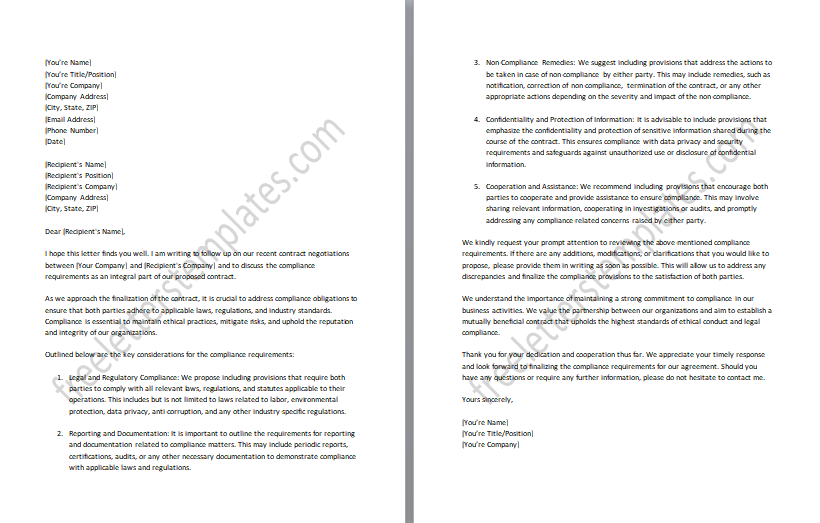
#28: Risk assessment analysis for contract negotiations
A risk assessment analysis for contract negotiations involves conducting a thorough evaluation of potential risks and uncertainties associated with a proposed contract or agreement. The purpose of this analysis is to identify, analyze, and mitigate risks that may impact the successful execution or performance of the contract. It involves a systematic examination of various factors, such as financial risks, legal and regulatory compliance risks, operational risks, market risks, and any other relevant areas of concern. The analysis aims to assess the likelihood and potential impact of each identified risk and develop appropriate strategies to manage or mitigate them. By conducting a comprehensive risk assessment analysis, the parties involved can make informed decisions, negotiate favorable terms, and implement risk mitigation measures to safeguard their interests and ensure a smoother and more secure contractual relationship.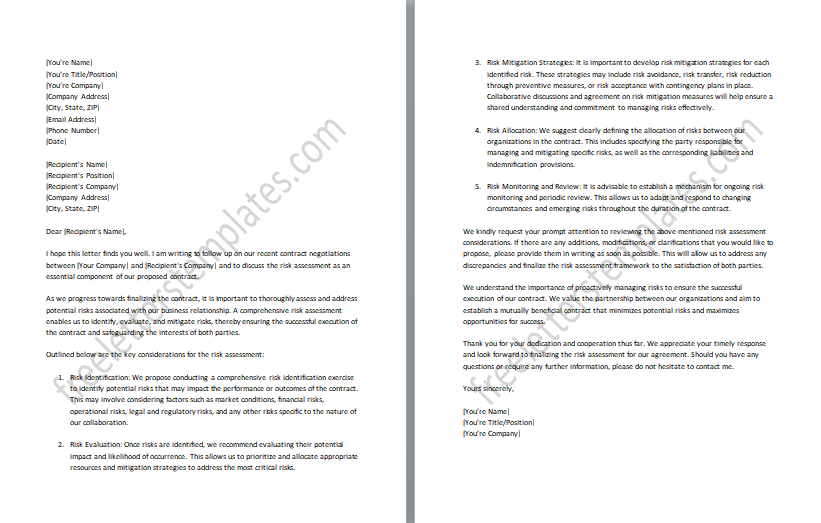
#29: Milestone payment schedule adjustment proposal
A milestone payment schedule adjustment proposal is a written communication used to propose changes or amendments to the existing payment schedule based on milestones achieved in a project or contractual agreement. The purpose of this proposal is to address any necessary modifications to the payment terms and schedule to better align with the progress and completion of specific project milestones. The proposal aims to reevaluate the timing and amounts of payments associated with each milestone, taking into consideration factors such as project delays, changes in scope, or other relevant circumstances. By presenting this proposal, the sender seeks to establish a fair and equitable payment schedule that reflects the actual progress of the project, ensures timely compensation for completed milestones, and maintains a positive cash flow for both parties. The goal is to engage in a constructive dialogue and reach a mutually agreed-upon adjustment to the milestone payment schedule that accommodates the evolving needs and circumstances of the project.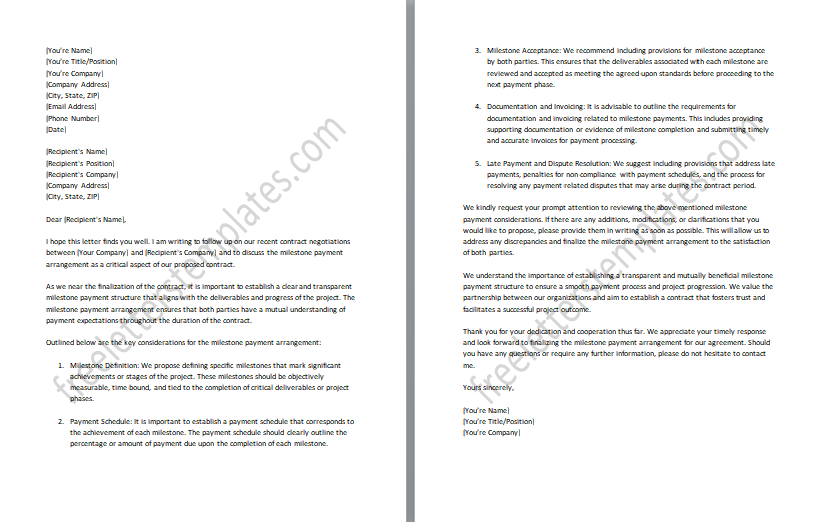
#30: Audit clause inclusion request for contract negotiations
An audit clause inclusion request for contract negotiations is a written communication used to request the inclusion of an audit clause in a contract being negotiated. The purpose of this request is to address the need for transparency, accountability, and verification of financial records, processes, or compliance with specific terms within the contract. The letter seeks to propose the inclusion of an audit clause that outlines the rights, procedures, and obligations regarding audits, including access to relevant documents, appointment of auditors, frequency, and scope of audits, confidentiality, and resolution of audit findings. By requesting the inclusion of an audit clause, the sender aims to establish a mechanism to ensure accurate reporting, and adherence to contractual obligations, and to address any potential concerns or discrepancies that may arise. The goal is to create a contractual framework that promotes trust, integrity, and effective financial management between the parties involved.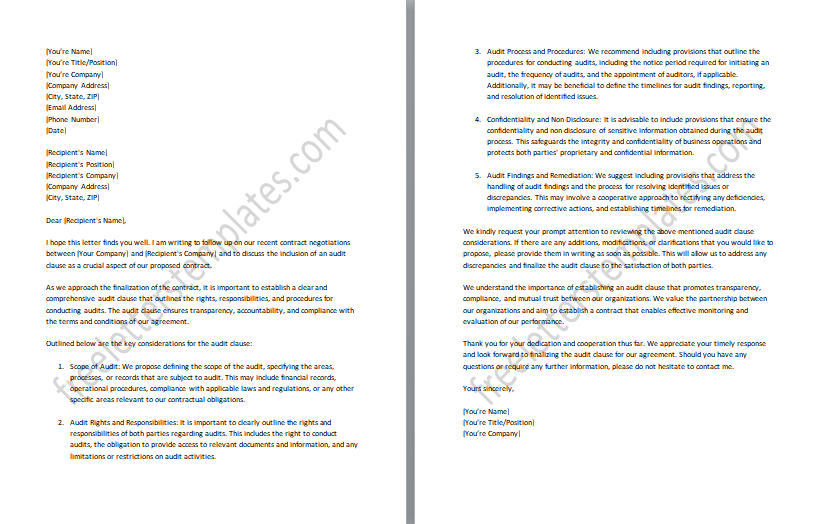
#31: Amendments proposal for contract terms
An amendments proposal for contract terms is a written communication used to propose changes or modifications to the terms and conditions of an existing contract. The purpose of this proposal is to address any necessary adjustments to the contract terms to better align with the evolving needs, circumstances, or objectives of the parties involved. The proposal aims to identify specific clauses or provisions that require modification and present alternative language or terms that better reflect the desired changes. This includes aspects such as pricing, delivery timelines, performance metrics, termination clauses, indemnification, warranties, or any other relevant terms. The goal is to foster a collaborative approach to contractual adjustments, ensuring clarity, fairness, and a mutually beneficial business relationship.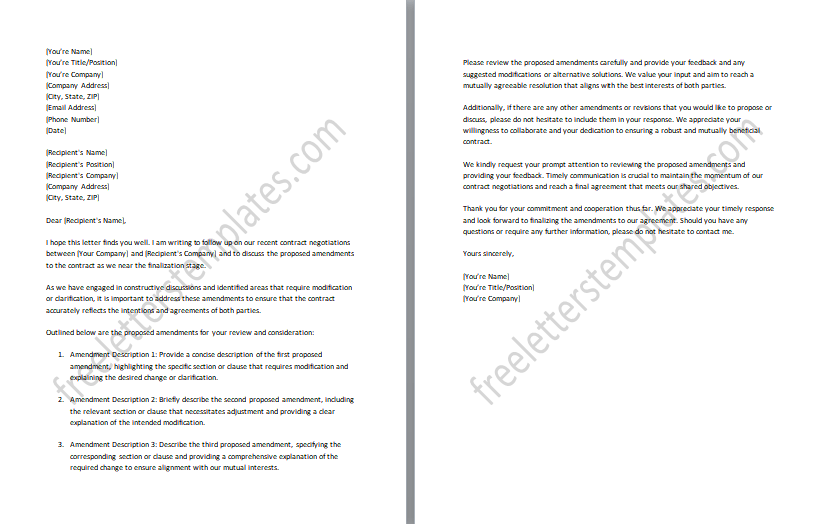
#32: Finalization and signing of the contract agreement
The finalization and signing of the contract agreement mark the culmination of our collaborative efforts and mutual understanding. This significant milestone solidifies our commitment and intent to uphold the terms and obligations outlined in the contract. Through careful negotiations, discussions, and revisions, we have reached an agreement that reflects our shared goals and priorities. The finalization process involves reviewing the contract to ensure accuracy, clarity, and legal compliance, followed by the signing of the document by all parties involved. This moment signifies our mutual trust and readiness to embark on a successful and productive partnership. As we affix our signatures, we look forward to the opportunities, challenges, and achievements that lie ahead, confident in the strength and integrity of our contractual relationship.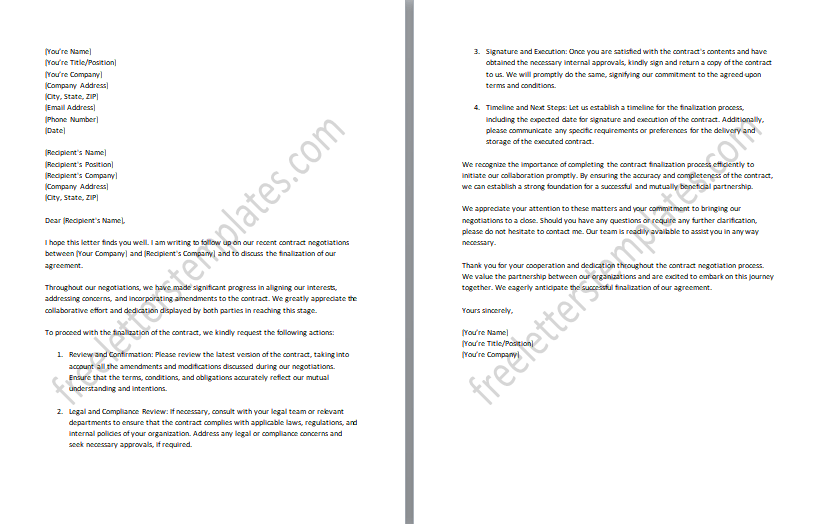
Language and Tone
The way we choose our words and set the tone in follow-up letters during contract negotiations holds immense significance. It’s all about finding the right balance between assertiveness and diplomacy to effectively convey our message and maintain a constructive dialogue. Being assertive allows us to express our thoughts and concerns clearly, ensuring that our voice is heard. However, it’s equally crucial to approach the conversation with diplomacy, fostering a positive and respectful atmosphere. To strike this balance, we should use respectful and professional language, avoiding any confrontational or aggressive statements. By thoughtfully selecting our words and maintaining a diplomatic tone, we can effectively communicate our message, promote understanding, and create an environment that encourages collaboration and problem-solving.
Negotiation Etiquette
Negotiation Etiquette: Maintaining professional etiquette is crucial during contract negotiations, including when writing follow-up letters. It sets the tone for respectful and constructive communication, helping to foster a positive negotiation environment. Here are some guidelines to uphold negotiation etiquette in your follow-up letters:
- Be Respectful: Treat all parties involved with respect and courtesy, regardless of any differences or disagreements. Use polite language and avoid personal attacks or offensive remarks. Focus on the issues at hand and maintain a professional tone throughout the letter.
- Choose the Right Words: Select your words carefully to convey your message effectively without causing unnecessary conflict or misunderstanding. Be mindful of the potential impact of your language and choose a diplomatic and constructive approach.
- Remain Objective: Keep your follow-up letters focused on the facts and the issues being discussed. Avoid emotional language or biased statements that may cloud the negotiation process. Stay objective and maintain a balanced perspective.
- Active Listening: Practice active listening not only during face-to-face negotiations but also when crafting follow-up letters. Reflect on the concerns and viewpoints expressed by the other party and respond thoughtfully to demonstrate your understanding and willingness to find common ground.
- Prompt Responses: Timely responses to follow-up letters are crucial to maintaining open lines of communication. Acknowledge receipt of letters promptly and avoid unnecessary delays in providing a thorough and thoughtful response. This demonstrates your commitment to the negotiation process.
- Clarity and Conciseness: Ensure that your follow-up letters are clear, concise, and well-organized. Use headings, bullet points, and numbered lists to present information in a structured manner. Avoid excessive jargon or technical language that may confuse or alienate the recipient.
- Collaborative Approach: Adopt a collaborative mindset when writing follow-up letters. Instead of adopting an adversarial or confrontational tone, focus on finding mutually beneficial solutions. Highlight areas of agreement and propose alternatives that address the concerns of both parties.
- Confidentiality and Privacy: Respect the confidentiality and privacy of information shared during negotiations. Avoid disclosing sensitive or proprietary details in your follow-up letters unless required or explicitly agreed upon. Maintain the trust and integrity of the negotiation process.
- Professional Demeanor: Project professionalism throughout your follow-up letters. Pay attention to grammar, spelling, and formatting to ensure a polished and well-presented document. Use a professional email signature and include your contact information for easy reference.
- Seek Win-Win Outcomes: Strive for win-win outcomes where both parties feel they have achieved their objectives. Emphasize the benefits of a mutually beneficial agreement and express a willingness to explore creative solutions to bridge any gaps.
Concluding Thoughts
In conclusion, understanding the significance of language and tone in follow-up letters for contract negotiations is essential for achieving successful outcomes. By employing appropriate language and striking a balance between assertiveness and diplomacy, we can effectively convey our message while maintaining a constructive dialogue. The tips and guidelines provided here serve as valuable tools to help navigate the complexities of negotiation communication. Remember, the way we communicate through follow-up letters can greatly impact the negotiation process and the overall relationship with the other party. By approaching these letters with professionalism, respect, and a focus on collaborative problem-solving, we can enhance the likelihood of reaching mutually beneficial agreements and fostering positive long-term partnerships.